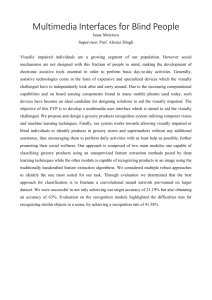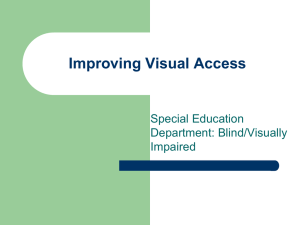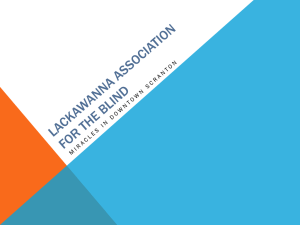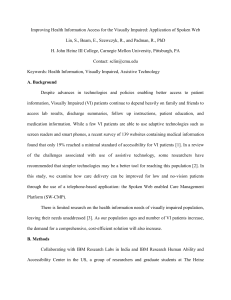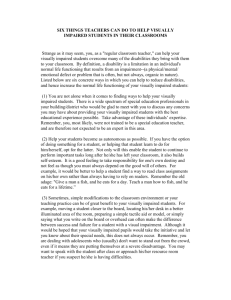View Sample Lesson in Word Format
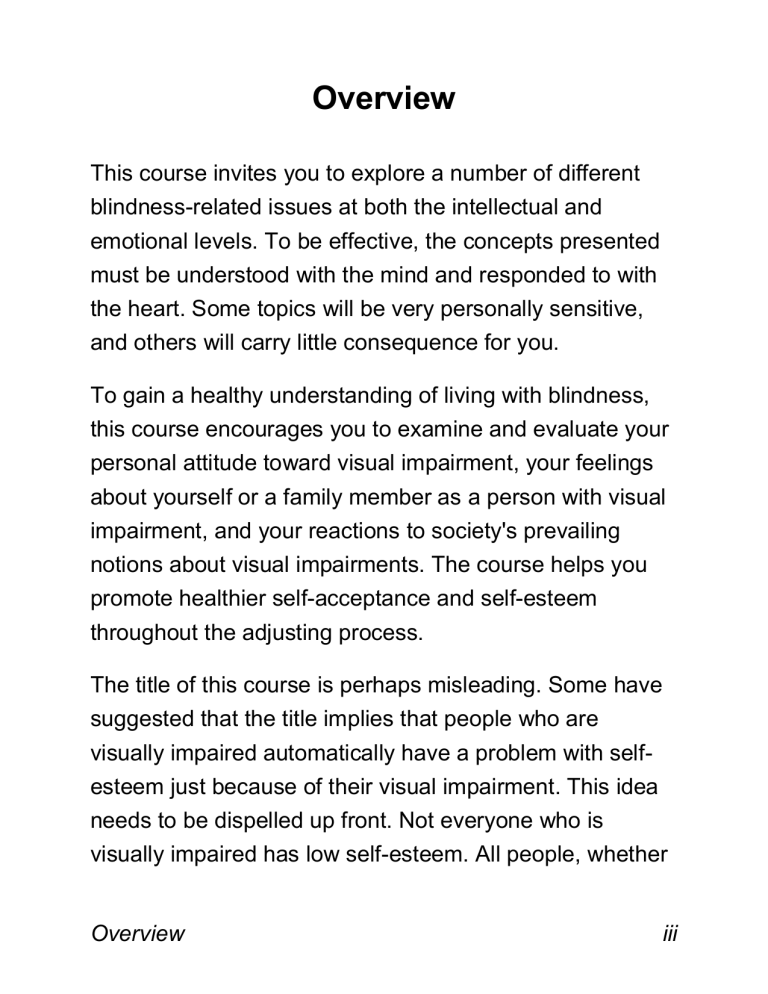
Overview
This course invites you to explore a number of different blindness-related issues at both the intellectual and emotional levels. To be effective, the concepts presented must be understood with the mind and responded to with the heart. Some topics will be very personally sensitive, and others will carry little consequence for you.
To gain a healthy understanding of living with blindness, this course encourages you to examine and evaluate your personal attitude toward visual impairment, your feelings about yourself or a family member as a person with visual impairment, and your reactions to society's prevailing notions about visual impairments. The course helps you promote healthier self-acceptance and self-esteem throughout the adjusting process.
The title of this course is perhaps misleading. Some have suggested that the title implies that people who are visually impaired automatically have a problem with selfesteem just because of their visual impairment. This idea needs to be dispelled up front. Not everyone who is visually impaired has low self-esteem. All people, whether
Overview iii
blind or sighted, struggle with their self-esteem from time to time. Perhaps the title of the course should read, "The
Ups and Downs of
Self-Esteem While Adjusting to Life's Demands with All of a Person's Attributes, Only One of Which Is Blindness."
Though more accurate, this title is much too long.
Self-esteem is an essential ingredient to people's wellbeing. It refers to the way people feel about themselves, their unique set of characteristics and qualities, and their special mix of strengths, interests, and abilities. The extent to which individuals are able to make choices, to exercise some control over themselves and the events in their lives, contributes to feelings of high or low self-esteem.
Just as an individual's personality is not solely the result of a visual impairment, there is no unique psychology of persons who are visually impaired. Rather, the general psychological principles that apply to all individuals are adequate and sufficient to explain the behavioral impact of a visual impairment. An individual who is visually impaired is a typical person responding to life's demands with the added characteristic of a sensory impairment. iv Self-Esteem and Adjusting with Blindness
The information for this course is presented in the textbook entitled Self-Esteem and Adjusting with
Blindness (third edition) and this study guide. The textbook, written by Dean and Naomi Tuttle, was published by Charles C. Thomas. The study guide was written by staff and faculty of The Hadley School for the
Blind.
The textbook is divided into four sections. The first one, A
Definition of Blindness, includes Chapters 1 and 2.
Chapter 1 provides an overview of blindness and explains the impact of a visual impairment on various aspects of life. Chapter 2 describes the psychosocial implications of blindness.
Section II, The Development of Self-Esteem, includes
Chapters 3 through 5. While Chapter 3 examines the external factors that influence self-esteem, Chapter 4 focuses on internal sources of self-esteem. Chapter 5 explains how self-esteem influences the way a person manages life's conflicts and discrepancies.
Section III, Adjusting with Blindness, includes Chapters 6,
7, and 8. Chapter 6 focuses on the first four phases in the process of adjusting with a visual impairment. Chapter 7
Overview v
describes the next three phases of this process. Chapter 8 identifies the internal and external factors that influence the adjusting process.
Section IV, Fostering Self-Esteem, includes Chapters
9 and 10. Chapter 9 provides guidelines and activities that nurture self-esteem. Chapter 10 presents actual testimonies from Hadley students as they've worked through issues associated with visual impairments.
Study guides are a popular way to complete distance education courses. They identify what you need to do to complete each chapter. In addition, this study guide summarizes and occasionally amplifies the material included in the textbook. It features self-directed activities and answers that serve as comprehension checks. The self-directed activities are for your personal development only. Do not send your answers to your Hadley instructor.
You are required, however, to submit the assignment at the end of each chapter. The assignment enables your instructor to evaluate your progress throughout the course.
If you are ready to explore the implications and effects of visual impairment on life and self-esteem, proceed with
Section I and Chapter 1 of this study guide. vi Self-Esteem and Adjusting with Blindness
Overview vii
Section I: A Definition of Blindness
The first section, A Definition of Blindness, includes
Chapters 1 and 2. This section helps you gain a better understanding of situations and experiences that result from a visual impairment. It realistically examines the effects of a visual impairment so you can separate fact from opinion. These effects or implications are treated in a very general sense. Each individual, however, is affected in a different manner and to a different extent. Therefore, as you read these chapters, make a conscious effort to determine how this information applies to you or to a family member.
Section I: A Definition of Blindness 1
2 Self-Esteem and Adjusting with Blindness
Chapter 1: Overview and Impact of
Blindness
Chapter 1 discusses the general field of blindness as well as the impact of a visual impairment. The first part of the chapter explains how a severe visual impairment can affect the development of a healthy self-esteem. This chapter provides a brief historical perspective of society's views toward people who are visually impaired, giving insight into current attitudes and practices. The chapter also explains the meaning of terms commonly found in literature related to visual impairment. It describes how the extreme variability of visual impairments, compounded by low incidence and prevalence, can lead to confusion and incorrect perceptions.
The second part of the chapter focuses on the permanent, temporary, or imagined impact of visual impairment on everyday life. It examines the obstacles that a person who is visually impaired faces as he or she tries to accomplish daily living chores. It explains how the ability to travel independently affects an individual's outlook on life. It explores the implications of a visual impairment on the
Chapter 1: Overview and Impact of Blindness 3
ability to read and write. It also looks at the possible consequences a visual impairment has on employment and recreational opportunities. Familiarizing yourself with this information helps you promote healthier selfacceptance and self-esteem throughout the adjusting process.
Objectives
After completing this chapter, you will be able to a. identify how a visual impairment impacts the development of self-esteem b. summarize the five phases in society's attitudes toward people who are visually impaired c. describe, using terms commonly found in blindnessrelated literature, how the extreme variability, low incidence, and prevalence factors of visual impairments affect people's perceptions of individuals who are visually impaired d. explain how a visual impairment influences self-esteem in the areas of personal and home management, travel, reading and writing, employment, and recreation
4 Self-Esteem and Adjusting with Blindness
Severe Visual Impairment and Self-Esteem
While people who are visually impaired are not unique in their desire to develop a healthy self-esteem, this section of Chapter 1 explains how a visual impairment might affect this basic human need. It defines self-esteem and illustrates the effects of childhood experiences and social environments on how people who are visually impaired feel about themselves.
Whether an individual is born blind (i.e., congenitally blind) or becomes blind later in life (i.e., adventitiously blind), adjusting with a visual impairment is a continuous process.
It requires the person who is visually impaired, the family, the teaching and rehabilitation staff, and many others to work together as a team.
This section discusses self-esteem and adjusting with a visual impairment. Use this information to help you consider how a visual impairment can influence how a person feels about him- or herself.
Overview of Blindness
This section briefly summarizes the social status of individuals with visual impairment throughout history. It
Chapter 1: Overview and Impact of Blindness 5
also discusses differences in vocabulary, the wide range of visual impairments, and the low prevalence and incidence of visual impairments in general.
Historical Perspective
Great progress has been realized in the past few decades.
People who are visually impaired are increasingly enjoying equal status in society. From a historical perspective, however, the era of separation when most people who were visually impaired were abandoned was followed by a period of protection that led to the establishment of sheltered environments. Nevertheless, as visually impaired individuals distinguished themselves by taking control of their own lives, more educational opportunities became available to people with visual impairments. Early on, this was done primarily in separate residential schools.
Educational trends in the 20th century gradually favored integrating children with visual impairments with their sighted peers.
Each of the five periods has its contemporary counterparts. Even today, not everyone believes that people who are visually impaired can be fully incorporated into society. Some individuals would be in favor of
6 Self-Esteem and Adjusting with Blindness
separating, protecting, and educating without accepting the fundamental right of every visually impaired person to fully participate in society. Nevertheless, full incorporation of visually impaired people into society prevails more and more, which hopefully will lead to increased acceptance.
Terminology
Vocabulary can be confusing until meanings are made clear. In the textbook, the authors tend to use blind and visually impaired more or less interchangeably. You may prefer one term over another, and that is quite natural.
Words do not carry precisely the same meaning, since each person draws from a different set of experiences.
A word of caution about one thing may be helpful, however. Avoid thinking in terms of a scale running from good to bad. For example, being sighted is good, having some residual vision is less desirable, and being totally blind is bad. To do so places value on people on the basis of their sight; with upper-, middle-, and lower-class citizens or first-, second-, and third-class people. Like their sighted counterparts, people who are visually impaired are of equal value regardless of their attributes and abilities.
Chapter 1: Overview and Impact of Blindness 7
Extreme Variability
This section illustrates how impossible it is to try to group into one category all persons who are visually impaired.
Vision varies according to distance from the object, extent of peripheral field, sensitivity to light, color discrimination, effectiveness of optical aids, and so on. The combination of these factors is what makes each person's situation unique.
The extreme variability of visual impairments may help explain how misunderstandings occur. Some visual impairments are obvious; others are not readily apparent.
The casual observer who makes up the general public often misunderstands the variability of visual conditions.
This can contribute to problems in identity and interpersonal relationships.
Prevalence and Incidence
Chances are, very few people have identical visual impairments. This low incidence and prevalence of visual impairments can have enormous consequences. First, the number of persons who are visually impaired at different years of age impacts greatly how families are affected and services are provided. Because little interaction takes
8 Self-Esteem and Adjusting with Blindness
place among persons who are visually impaired, not to mention between people who are sighted and people who are visually impaired, unrealistic expectations and misunderstandings can arise.
This section presented a brief overview on the topic of visual impairment. Use this information to help you consider the attitudes you've encountered about people with visual impairments and your reactions to the material presented in this study guide.
The Impact of Blindness
This section describes how a visual impairment impacts a person's lifestyle. While a visual impairment doesn't prevent an individual from living a full and satisfying life, it does impose limitations. These limitations occur in three basic areas:
1. the range and variety of experiences
2. the ability to move through the environment
3. the control of the environment and the self in relation to it
Chapter 1: Overview and Impact of Blindness 9
This section discusses the various implications that these limitations have on the lifestyles of people who are visually impaired.
Implications for Personal and Home Management
This section of Chapter 1 explains that, with accommodations and adapted skills, people with visual impairment can handle basic everyday tasks quite capably, like personal grooming, eating, and home maintenance. Individuals experience personal satisfaction when they are able to manage their lives more independently. The ability to independently manage personal needs leads to feelings of competence and a sense of accomplishment, which contribute to feelings of self-worth, or self-esteem.
Implications for Travel
Undoubtedly, one of the most significant consequences of a visual impairment is the need to travel through the environment in a competent and safe manner. This section focuses on how travel skills are acquired through orientation and mobility instruction. It describes the three primary modes of mobility used by people who are visually impaired: sighted guide, cane, and dog guide.
10 Self-Esteem and Adjusting with Blindness
Despite these proven techniques, however, other factors need to be considered as well. This section describes how the unpredictable nature of low vision can cause confusion and even anxiety. Also, some people struggle with their self-image and therefore reject symbols of their disability, such as the use of a white cane. Likewise, a teenager who is visually impaired needs to come to terms with missing out on a significant milestone of adolescence when his or her sighted peers obtain their driver's license. An older person facing a recent vision loss may resent having to rely on other people for transportation.
Implications for Reading and Writing
With the written word undeniably present in all aspects of life, a visual impairment has significant impact on someone's ability to read and write. This section explains how an individual who is visually impaired can communicate effectively through braille, large print, or recorded materials. Extraordinary technological improvements, especially in computer software and adaptive equipment, and access to the Internet with its variety of Web sites greatly enhance a person's ability to communicate. Regardless of the techniques that are used
Chapter 1: Overview and Impact of Blindness 11
to read and write, however, other less-obvious considerations may affect feelings of competence in this area as well.
Implications for Employment
Today's job market offers ever-increasing opportunities for people who are visually impaired. Nevertheless, some concerns still exist, such as unemployment, underemployment, and limited career advancement. This section describes some of the obstacles that might interfere with obtaining satisfying employment, like employers' attitudes or transportation issues, to name just two.
For a youngster who is visually impaired, early career education is essential and consists of a team approach to carefully arranged activities. An individual who becomes visually impaired later in life faces inevitable work disruption until he or she develops the skills to travel, communicate, and handle daily living tasks in a competent manner. Regardless of a person's visual impairment, however, current trends allow people to tailor their job search to match their personality, interests, and abilities.
12 Self-Esteem and Adjusting with Blindness
Implications for Recreation
Leisure-time activities promote personal satisfaction, productivity, and social companionship, whether an individual is sighted or visually impaired. Whatever the activity, opportunity and training allow full participation, with few exceptions. Many choices —crafts, hobbies, sports, surfing the Internet —allow people who are sighted and people who are visually impaired to enjoy each other's company, as well as that of family or friends.
Radio, television, recordings, or computer games may be worthwhile activities for some individuals, some of the time. Still, people with visual impairment can explore many other recreational opportunities to see what they enjoy the most. Engaging in leisure-time activities supports feelings of achievement and self-worth.
This section discussed some lifestyle implications for people who are visually impaired. Use this information to help you consider how your or your family member's lifestyle is affected by a visual impairment.
Chapter 1: Overview and Impact of Blindness 13
Study Guidelines
1. Read Chapter 1 in the textbook .
2. Return to the study guide to complete the self-directed activity.
3. Compare your answers to those in the study guide.
4. Complete and submit the assignment.
Self-Directed Activity
Test your knowledge of the material in this chapter by completing this self-directed activity. Do not send your answers to your instructor, however, as this activity is for your personal development only.
1. Historically speaking, what are the different ways that society has treated people who are blind?
2. What does the term legally blind mean, and how did it originate?
3. Name some vision-related factors that contribute to the extreme variability among persons who are visually impaired.
4. Vision loss does impact the life and lifestyle of a person who is visually impaired. Name the five areas discussed in Chapter 1.
14 Self-Esteem and Adjusting with Blindness
5. Identify the three primary travel aids available to assist with mobility.
6. Identify five barriers to employment that persons with visual impairment experience.
7. List five recreational opportunities available to persons who are visually impaired.
Answers
1. From a historical perspective, society has separated, protected, educated, and integrated persons who are visually impaired.
2. The 1935 Social Security Act established the definition of legally blind as a visual acuity of 20/200 or less in the better eye with best correction or restriction in the field of vision to less than 20 degrees. This was done to establish eligibility requirements for benefits.
3. Vision-related factors that contribute to the extreme variability of visual impairments could include distance from object, extent of peripheral field, sensitivity to light, color discrimination, and effectiveness of optical aids.
Chapter 1: Overview and Impact of Blindness 15
4. Personal and home management, travel, reading and writing, employment, and recreation are the five areas of daily life impacted by a loss of vision.
5. The three primary travel aids that assist with mobility needs are sighted guide, cane, and dog guide.
6. Barriers to employment could include negative public attitudes, poor self-concept, resistance of employers to hire, poor career planning, insufficient vocational training, and inadequate transportation.
7. Persons who are visually impaired can pursue various recreational opportunities, such as hobbies, collections, arts and crafts, games, sports, hiking, dancing, concerts, movies, and so on.
Summary
This chapter began with a discussion of the effects of visual impairment on self-esteem. It then went on to briefly explain visual impairment from a historical perspective, important vocabulary, and the unique characteristics and needs of individuals who are visually impaired. Finally, the chapter touched on how daily living is impacted by a visual impairment.
16 Self-Esteem and Adjusting with Blindness
Chapter 1: Overview and Impact of Blindness 17
Assignment 1
For information on completing assignments, refer to the instructions entitled "Getting Started." Then begin this assignment by giving your full name, address, and phone number. Also list the name of this course, Assignment 1, your instructor's name, and the date. Be sure to include the question number along with each answer.
1. This question is designed to help you begin sharing your feelings. Using your or your family member's first, middle, and last names, identify three adjectives that describe the person with the visual impairment and that start with the first letter or sound of the three names. For example: Dorothy Jane Thomas might describe herself as Deliberate Dorothy, Joyful Jane,
Tired Thomas. Are the adjectives you have chosen accurate and realistic?
2. Describe your visual impairment or that of your family member, especially in the following areas: cause of vision loss, visual acuity, peripheral vision, color vision, effect of dim or bright lights, use of magnifiers, and fatigue. Do you or your family member see better with one eye than the other? Do you or your family
Assignment 1 18
member see better when not looking directly at something?
3. Whether congenital or adventitious, how does visual impairment influence your or your family member's feelings? In what ways has the visual impairment affected how things are done? Has your or your family member's lifestyle changed?
4. Which of the five implications discussed in this chapter would you or your family member find most challenging and why?
5. Some persons who are visually impaired see themselves as quite different from their sighted companions. Moreover, some sighted persons may let differences distort and dominate the entire relationship. Do you feel that persons with visual impairment are more different from or more like sighted persons? Give reasons for your answer.
6. A short biographical sketch follows. It is taken from
Lend Me an Eye, by A. Vajda (New York: St. Martin's
Press, 1975). As you read it, consider what issues are raised. Is the author really proving that he is independent? Is he comfortable with himself as a
Chapter 1: Overview and Impact of Blindness 19
20 person who is visually impaired or is he pretending?
What dangers exist in pretending?
"At the same time, I hated being dependent on others. And so I invented the 'change-over method.' I would leave the house, stop in the street and wait for a suitable passerby. When possible, I chose a woman in a bright dress or coat who stood out clearly against the dull grayness of the pavement and the houses. I would then follow her from a distance of a couple of yards. When she stopped at a crossing, I would stop, too. If she crossed the street, so would I. But if she changed her direction and no longer led me where I wished to go, I would simply 'change-over' to another conspicuously dressed woman. This is how I made use, for years, of my fellow humans, who did not even suspect that they were protecting not only their own lives and health against the hazards of metropolitan traffic, but also mine. I felt like a cuckoo that laid its eggs in the nest of another bird and allowed it to bring up its chicks.
However, there was nothing else I could do. I had
Self-Esteem and Adjusting with Blindness
to prove to myself that I could get along on my own."
Once you have completed this assignment, send it to your instructor. Then continue in this study guide to begin
Chapter 2: Psychosocial Implications of Blindness.
Chapter 1: Overview and Impact of Blindness 21


